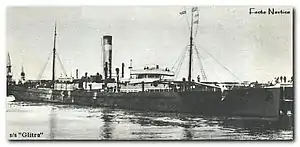 | |
| History | |
|---|---|
| Name |
|
| Owner |
|
| Operator |
|
| Port of registry |
|
| Builder | CS Swan & Hunter, Wallsend |
| Yard number | 51 |
| Launched | 3 March 1881 |
| Completed | April 1881 |
| Identification |
|
| Fate | Captured and scuttled, 20 October 1914 |
| General characteristics | |
| Tonnage | 866 GRT, 527 NRT |
| Length | 215 ft (66 m) |
| Beam | 30.7 ft (9.4 m) |
| Depth | 13.8 ft (4.2 m) |
| Installed power | 99 NHP |
| Propulsion | Compound steam engine |
| Speed | 9 knots (17 km/h) |
SS Glitra was a steam cargo ship that was launched in 1881 as Saxon Prince. In 1896 she was renamed Glitra. In 1914 she became the first British merchant vessel to be sunk by a U-boat in the First World War.
Building and ownership
Saxon Prince was the first steamship to be built for James Knott, a successful owner of collier brigs. She was also the first ship to which Knott gave a name ending in "Prince", which became a characteristic of his future Prince Line.[1]
CS Swan & Hunter built Saxon Prince at Wallsend, launching her on 3 March 1881 and completing her that April. She had an iron hull and a two-cylinder compound steam engine.[2] Her UK official number was 79247, her code letters were VLQW and Knott registered her in North Shields.[3]
In 1895 Knott restructured his business as Prince Line (1895) Ltd and sold Saxon Prince to Christian Salvesen. In 1896 Salvesen renamed her Glitra and registered her in Leith.[2][4][5]
Capture and sinking

On 20 October 1914 Glitra was en route from Grangemouth to Stavanger in Norway laden with coal, iron plate and oil when U-17, commanded by Kapitänleutnant Johannes Feldkirchener, stopped and searched her 14 nautical miles (26 km) west-southwest of Skudenes, Rogaland, Norway, in accordance with prize law. Her crew was ordered into the lifeboat(s),[6] and once all were safely off the ship a German boarding party scuttled Glitra by opening her seacocks.[7][8]
One source states that U-17 towed the lifeboat(s) toward the Norwegian coast.[8] Another states that the Royal Norwegian Navy 1. class torpedo boat HNoMS Hai, which was on neutrality protection duty, observed the incident but did not intervene as it was in international waters, and that after U-17 left, Hai towed the lifeboat(s) to the port of Skudeneshavn.[9]
References
- ↑ Burrell 1992, p. 69.
- 1 2 "Saxon Prince". Tyne Built Ships. Shipping and Shipbuilding Research Trust. Retrieved 1 February 2021.
- ↑ Registrar General of Shipping and Seamen (1882). Mercantile Navy List. Board of Trade. p. 128. Retrieved 1 February 2021 – via Crew List Index Project.
- ↑ Registrar General of Shipping and Seamen (1898). Mercantile Navy List. Board of Trade. p. 147. Retrieved 1 February 2021 – via Crew List Index Project.
- ↑ Helgason, Guðmundur. "Ships hit during WWI: Glitra". German and Austrian U-boats of World War I - Kaiserliche Marine - Uboat.net. Retrieved 24 March 2008.
- ↑ Note: sources disagree as to whether Glitra's crew left in one lifeboat or more than one.
- ↑ "British Merchant Ships Lost to Enemy Action Part 1 of 3 – Years 1914, 1915, 1916 in date order". Naval History. 2 August 2011. Retrieved 20 January 2013.
- 1 2 Burrell 1992, p. 65.
- ↑ Hegland & Lilleheim 1998, p. 43.
Bibliography
- Burrell, David (1992). Furness Withy 1891–1991. Kendal: World Ship Society. ISBN 0-905617-70-3.
- Hegland, Jon Rustung; Lilleheim, Johan Henrik (1998). Norske torpedobåter gjennom 125 år (in Norwegian). Hundvåg: Sjømilitære Samfund ved Norsk Tidsskrift for Sjøvesen. ISBN 82-994738-1-0.